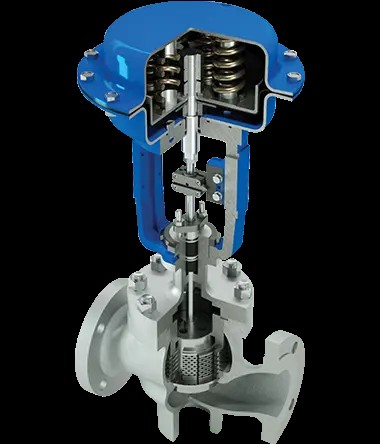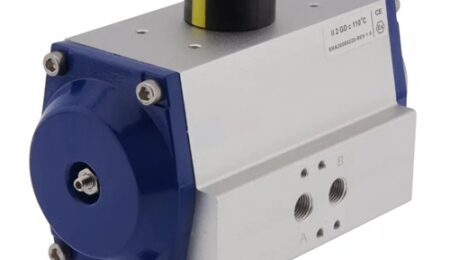Introduction
Pneumatic Globe Control Valves are vital components in industrial systems, ensuring precise regulation of fluid flow, pressure, and temperature. These valves utilize pneumatic actuators that adjust the valve’s position in response to control signals, providing optimal fluid control. This article explores the essential working principles, components, and considerations for selecting and maintaining a Pneumatic Globe Control Valve.
Understanding the Globe Valve Body
The globe valve body is the central part of the valve that directly interacts with the pressurized fluid within the system. It houses the internal components such as the valve stem, disc, and seat. Typically, globe valves are designed as two-port valves, where the inlet and outlet are positioned either directly opposite or at a 90° angle, as seen in angle globe valves.
Globe valves are known for their capability to handle high-pressure, high-temperature, and corrosive or viscous fluids. However, when installed on horizontal pipelines, globe valves can accumulate residual fluids within the valve body if left unused for long periods, which may lead to clogging or corrosion. To address this, angle or oblique globe valves are recommended for better fluid drainage when the valve is not in use.
The materials used in constructing the globe valve body play a crucial role in its performance. Common materials like heat-resistant alloys, stainless steel, and carbon steel offer resistance to challenging operating conditions typically found in industries like chemical processing, oil and gas, and power generation.
The Pneumatic Actuator: A Vital Component
Pneumatic actuators are essential for the operation of Pneumatic Globe Control Valves, providing the mechanical force needed to open and close the valve. There are two primary types of pneumatic actuators: piston actuators and diaphragm actuators. Unlike rotary motion actuators for ball or butterfly valves, pneumatic actuators for globe valves use a linear motion to move the internal components.
In piston-type actuators, compressed air forces the piston to move up or down, driving the valve stem to adjust the internal components. Diaphragm actuators, on the other hand, rely on the pressure difference between the pneumatic supply and diaphragm to achieve similar motion. Both actuator types offer precise control, allowing accurate regulation of fluid flow, pressure, and temperature.
Working Principle of the Pneumatic Globe Control Valve
The Pneumatic Globe Control Valve operates based on fluid dynamics and pneumatic control principles. When the actuator receives a control signal from a process controller or supervisory control system, it moves the valve’s internal parts (spool or plug) up or down, regulating the flow rate, pressure, or temperature according to the setpoint.
The actuator is powered by compressed air, and feedback mechanisms continuously adjust the valve’s position to maintain precise control over the fluid system. Sensors or transmitters monitor variables like flow rate or pressure, providing real-time data to the control system, ensuring the valve stays in the correct position for optimal performance.
Choosing the Right Pneumatic Globe Control Valve
Selecting the correct Pneumatic Globe Control Valve is crucial for ensuring efficient and reliable performance. Several factors must be considered:
-
Valve Body Material
The valve body material is essential for durability and resistance to the controlled fluid. Stainless steel is preferred for corrosive or high-temperature applications due to its superior resistance to corrosion and erosion. For less demanding applications, cast iron is a cost-effective option offering reliable performance. -
Actuator Type
Pneumatic actuators come in two configurations: single-acting and double-acting. Single-acting actuators are typically used in emergency shut-off situations, requiring rapid closure of the valve. Double-acting actuators, ideal for frequent valve operation, provide more consistent and reliable performance over time. -
Key Parameters
Consider the specific requirements of the application, including desired flow range, operating temperature, and pressure ratings. These factors ensure that the valve can withstand the operating conditions and deliver reliable performance.
Installation and Maintenance Recommendations
Proper installation and regular maintenance are vital for ensuring the long-term efficiency and reliability of Pneumatic Globe Control Valves.
Installation Precautions
-
Centering the Valve: Ensure the valve is properly centered within the pipeline to avoid misalignment, which can lead to leaks and damage to valve components.
-
Flow Direction: Always confirm that the fluid flow direction aligns with the markings on the valve body. Incorrect installation can result in poor valve performance and potential damage.
Daily Maintenance
Regular maintenance is crucial to keep the valve operating smoothly:
-
Cleaning: Periodically clean the valve spool and seat to remove debris or contaminants that may obstruct movement. Accumulated material can cause the valve to stick, reducing reliability.
-
Lubrication: Apply lubrication to the actuator’s moving parts to minimize friction and wear, extending the valve and actuator lifespan.
Troubleshooting
Common issues with Pneumatic Globe Control Valves include:
-
Actuator Failure: If the actuator malfunctions, first check the pneumatic air supply and ensure the air pressure is within the required range. Inspect signal connections to ensure they are correctly configured. A drop in air pressure or faulty signal connections can prevent the actuator from operating correctly.
-
Leaking Valve: If the valve leaks, inspect the valve seat and seal for wear or damage. A worn seal may need replacement to restore proper sealing performance.
Conclusion
Pneumatic Globe Control Valves are versatile and dependable components used across various industries for precise control of fluid flow, pressure, and temperature. By understanding the working principles, key components, and factors such as valve material, actuator type, and operating conditions, organizations can make informed decisions regarding valve selection and maintenance. Regular installation checks and proactive maintenance ensure these valves perform optimally and have a long lifespan, making them essential in modern industrial systems.Know more about Google SEO Directory



Leave a Reply